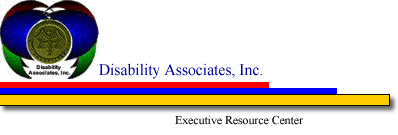
| Ask a Question | All Categories | Products |
Operations List of Categories
Page 1 Page 2
Page 3 Page 4
Page 5
- All materials have been sent to the SSA District Office. Now what do I do?
- The case is at the DDS. What action should I take now?
- My client just received a questionnaire from SSA. What should I do?
- SSA indicating the need for a consultative examination. What should I do?
-
How do I prepare a client for a consultative examination?
- What will SSA do with the consultative examination (CE) results?
- What if the client refuses to take a consultative examination?
- Who pays for the consultative examination?
- All materials have been sent to the
Social Security DO
Office. Now what do I do?
It can take several weeks for the DO to finish their portion of the case development process, which includes making sure all required forms are on file. Once this occurs, the DO will send the case to the Disability Determination Section (DDS). The case will then sit at the DDS until it is assigned to an Examiner. This can take another week or two depending upon the State caseload.
To top
- The case is at the DDS.
What action should I take now?
After the case has been transferred to the DDS, you should set up and implement a follow-up schedule. You control when and how frequently the follow-up contacts to the claimant or Social Security are made. The following is Disability Associate's follow-up contact schedule:1. Contact the Social Security District Office 10 days after the application has been made to determine the
status of the case. You want to find out if the case has been transferred to the DDS. During this same
time frame, the client may receive notices from Social Security indicating that he may or may not be
eligible due to income and resources.2. Once the case has been transferred to the DDS, wait at least 10 more days to determine if the case has
been assigned to an Examiner. If it has, find out the Examiner's name and phone number.3. A week or two after the case has been assigned to a DDS Examiner, contact the examiner to determine
if there is anything you can do to help him/her in expediting the case.4. Do follow-up contacts every two or three weeks to determine the status of the case.
To top
- My client just received a questionnaire from
Social Security. What should I do?
You should assist the claimant in completing the form. This can be done by phone or via the Internet. Make sure that the client doesn't say something in the questionnaire that would sabotage the case.
To top
- My client just received a letter from
Social Security indicating the need for a consultative examination. What should I do?
A consultative medical examination is used by Social Security to fill in gaps in the medical evidence. If Social Security feels that there is not enough evidence to make a decision, the examiner will order a consultative examination. The claimant must attend the examination. As the client's representative, it is your duty to prepare the client for it.
To top
-
How do I prepare a client for a consultative examination?
Tell the client these things:1. Do not lie or exaggerate your condition.
2. Cooperate with the examining physician.
3. Provide detailed information describing how the impairment is limiting your ability to perform work.
4. During the examination, perform only those physical activities that do not cause pain or discomfort.
To top
- What will SSA do with the consultative examination (CE) results?
Social Security will send your client to one of their hand-picked doctors. The report generated by the CE doctor usually favors Social Security's position on the case. That is why it may be wiser for the client to be examined by his own doctor if his doctor believes that he is disabled.
To top
- What if the client refuses
to take a consultative examination?
If the client refuses to take a consultative examination (CE), Social Security will deny the case on the basis of "Failure to Cooperate." If you or the client feel that you would get a more objective examination from the client's own doctor, then set-up an examination with that doctor. Let Social Security know about the client's plan to see his own physician for an examination. This action will prevent Social Security from denying the case before the examination is reviewed by the Social Security's staff physicians.
To top
- Who pays for the consultative examination?
If you approach it correctly, Social Security will pay for the examination. The trick is in who orders the CE. If Social Security requests a CE, they are responsible for the fee. You can even request that Social Security pay for the examination by the client's doctor as well. Social Security will usually agree to pay if they were the source of the original request for a consultative examination.
To top
Copyright © 2007 - 2011. Disability Associates, Inc. All Rights Reserved.